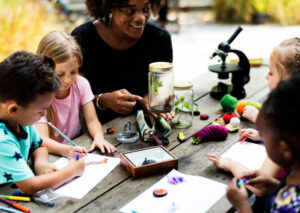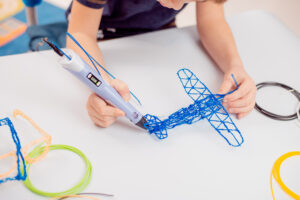
In today’s rapidly changing world, educators are constantly challenged to adapt their curriculum to best prepare students to enter the workforce. One adaptation gaining widespread attention is the emphasis placed on STEAM-based learning.
Recently, educators have begun placing emphasis on the A in STEAM, which stands for art, because it is a great way to foster creativity and innovation. Likewise, emerging research shows that students are more likely to comprehend and retain information in the other STEAM disciplines when art is incorporated into the lesson because they are more engaged. This is especially important because it allows students with different learning styles to foster deeper connections with what they are learning.
The History of STEAM Education
STEM education was first introduced to the world of education in the 1990s, and the concept spread like wildfire. Teachers everywhere were excited to implement STEM lessons into their curriculum because it requires students to use skills such as problem-solving, critical thinking, and collaboration to be successful.
The Addition of the “A”
 Several years after STEM gained traction, educators realized it lacked a certain element: a creative application. This led to the addition of the A into the STEAM framework. The purpose of adding the A was to enhance the existing STEM framework by allowing students to express themselves creatively. The ultimate goal is to create a more well-rounded workforce that can think analytically and creatively to solve problems.
Several years after STEM gained traction, educators realized it lacked a certain element: a creative application. This led to the addition of the A into the STEAM framework. The purpose of adding the A was to enhance the existing STEM framework by allowing students to express themselves creatively. The ultimate goal is to create a more well-rounded workforce that can think analytically and creatively to solve problems.
Learn more about STEAM education.
Benefits of Incorporating the “A”
The Data
Polls show that most Americans favor keeping the arts in school. In fact, a 2005 Harris Poll showed that “93% of Americans agree that the arts are vital to providing a well-rounded education for students.”
 Although the public sentiment around art education is high, this program is often overlooked by parents and policymakers who focus more on the product that is created rather than the process of how it was made.
Although the public sentiment around art education is high, this program is often overlooked by parents and policymakers who focus more on the product that is created rather than the process of how it was made.
Art education has the ability to enrich a student’s educational experience while providing benefits that will last a lifetime. Educators everywhere have noticed the positive benefits of incorporating artistic expression in their lesson plans, saying it helps their students reduce anxiety and stress, build social, emotional, and interpersonal skills, improve focus, and boost self-esteem. But beyond that, studies show that students involved in the arts perform better on standardized academic tests.
For example, students who were enrolled in arts courses for multiple years were more likely to score higher on their SAT scores, according to a 2005 study from College-Bound Seniors: Total Group Profile Report.
Long-Term Gains
The U.S. economy and job market are changing rapidly, and our responsibility is to ensure our education system keeps up. And let’s face it, real-world problems require real world-solutions. Workers must be able to think critically and creatively to solve multifaceted problems as a team.
The National Art Education Association lists four primary skills, often referred to as the “Four C’s,” needed for success in the 21st-century workforce:
- Critical thinking and problem-solving
- Communication
- Collaboration
- Creativity and innovation
Successfully engaging in a STEAM-based lesson plan requires students to use all these skills, which is important because employment in STEM-based occupations is expected to grow by 10.8% in the next nine years.
How to Incorporate the A in Your Lesson Plans
 Now that you have the facts, it’s time to incorporate STEAM into your lesson plan (if you haven’t already)! Fortunately, there’s no shortage of premade lesson plans available to help. In fact, Space Foundation has a whole library of STEAM lessons available for free for teachers.
Now that you have the facts, it’s time to incorporate STEAM into your lesson plan (if you haven’t already)! Fortunately, there’s no shortage of premade lesson plans available to help. In fact, Space Foundation has a whole library of STEAM lessons available for free for teachers.
One of our favorite lessons is “The View is Beautiful.” In this activity, kindergarten through fifth-grade students will join The Peanuts Characters on a space-themed mission where they will read “Snoopy: The First Beagle on the Moon,” to learn how light travels in space, study constellations, and use their creative minds to create a 3D constellation of their own.
Artistic Space-Themed STEAM Activities for Elementary School
“The View is Beautiful” is an example of a pre-made lesson plan you can use, but you can also design your own. Here are some tips for writing a STEAM lesson plan:
- Design your lesson around a math or science concept your students have studied or are currently learning.
- Make sure you fully understand the content of your lesson to best assist students with questions.
- Keep the challenge and task realistic to your students’ level of understanding.
- Understand the Engineering Design Process (EDP) and how it is used to problem-solve.
- Encourage students to collaborate and work together to devise a solution to the problem. Better yet, encourage students to work with people they usually do not interact with.
- Look for ways to incorporate technology or new applications in your lessons to engage students.
- Allow students to take risks and learn through trial and error.
- Find ways to let students creatively show what they learned.
Learn more about the benefits of teaching STEAM.
Get STEAM Teaching Resources from Space Foundation’s Center for Innovation and Education
Now that you’ve learned more about incorporating STEAM into your classroom, take a moment to explore all the resources available from Space Foundation’s Center for Innovation and Education. We offer programs for teachers, e-learning tools, and ready-to-go lesson plans available for free on our website. Visit now!